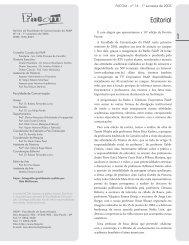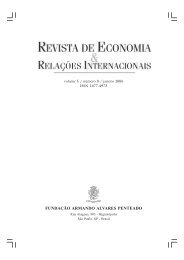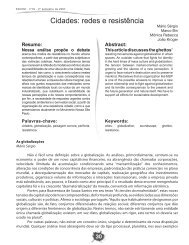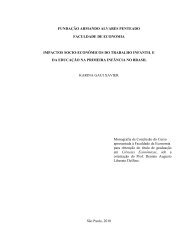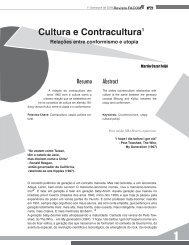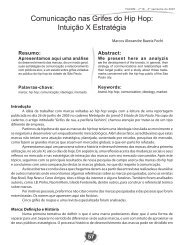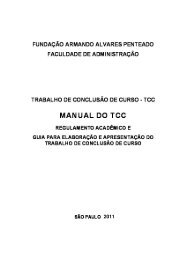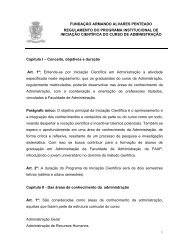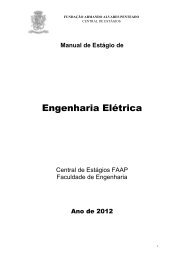GUIA DE ESTUDOS / STUDY GUIDE / GUIA DE ESTUDIOS - Faap
GUIA DE ESTUDOS / STUDY GUIDE / GUIA DE ESTUDIOS - Faap
GUIA DE ESTUDOS / STUDY GUIDE / GUIA DE ESTUDIOS - Faap
Create successful ePaper yourself
Turn your PDF publications into a flip-book with our unique Google optimized e-Paper software.
Guia de Estudos / Study Guide / Guia de Estudios<br />
History of the Court<br />
The International Court of Justice (ICJ) is the most important<br />
judicial organ of the United Nations (UN) and<br />
it was established in 1945, the same year as the UN,<br />
through the United Nations Charter 2 . The Court began<br />
its activities the following year as a replacement of the<br />
Permanent Court of International Justice (PCIJ). The<br />
International Court of Justice is the successor of the<br />
Permanent Court of International Justice (PCIJ) which<br />
was created in 1922 and formally dissolved in 1946.<br />
The PCIJ was the “first permanent international tribunal<br />
with general jurisdiction” 3 and contributed towards<br />
the development of the international law.<br />
Attached to the United Nations Charter, is the Statute<br />
of the International Court of Justice. The Statute verses<br />
over the organization of the Court, its competence and<br />
procedures. The Court’s composition is of 15 judges who<br />
are elected by two of the United Nations organs: the Security<br />
Council (SC) and the General Assembly (GA). To be<br />
elected, the candidate must receive an absolute majority<br />
(2/3 of 15) of the votes in the general Assembly and<br />
Security Council, according to article 10 of the Statute. 4<br />
The Court is composed by independent judges,“(…)<br />
elected regardless of their nationality from among persons<br />
of high moral character, who possess the qualifications<br />
required in their respective countries for appointment<br />
to the highest judicial offices, or are jurisconsults<br />
of recognized competence in international law.” 5<br />
In a time where the United Nations was searching for<br />
methods to solve disputes between countries in a<br />
peaceful manner, ICJ was created as the as an attempt<br />
to decide disputes using international law as instrument<br />
and the creation of the Court represented the<br />
culmination of a long development of methods for the<br />
pacific settlement of international disputes, the origins<br />
of which can be traced back to classical times. 6<br />
In 1943, after a conference held amongst the United<br />
States, the United Kingdom, China and the Soviet Union<br />
(USSR), the need for an International Organization<br />
was acknowledged. As a consequence of the conference,<br />
these States emitted a declaration that concerned<br />
the exigency<br />
(…) of establishing at the earliest practicable date<br />
a general international organization, based on the<br />
principle of the sovereign equality of all peace-loving<br />
States, and open to membership by all such States,<br />
large and small, for the maintenance of international<br />
peace and security. 7<br />
As an aftermath of the declaration, in October/1944,<br />
proposals for the foundation of an International Organization<br />
were published, and also among them, was<br />
the establishment of an international court of justice.<br />
The next year, in 1945, a meeting was arranged to prepare<br />
a draft of the Statute of the Court of Justice, the<br />
future ICJ. Such meeting was conducted by a North<br />
American jurist, G. H. Hackworth, and had the presence<br />
of 44 jurists, each representing their own State.<br />
As a base for the ICJ’s Statute, the PCIJ’s Statute was<br />
used, and because of that inspiration, the text was not<br />
completely original.<br />
The final form of the Statute was discussed by 50 States<br />
at the San Francisco Conference, the same which discussed<br />
the United Nations Charter.<br />
The Conference decided against compulsory jurisdiction<br />
and in favor of the creation of an entirely new court,<br />
which would be a principal organ of the United Nations,<br />
on the same footing as the General Assembly, the Security<br />
Council, the Economic and Social Council, the Trusteeship<br />
Council and the Secretariat, and with the Statute<br />
annexed to and forming part of the Charter. 8<br />
On the 31 st of January of 1946 the resignation of all PCIJ<br />
judges occurred, and, on February 6th 1946, the first<br />
members of the ICJ were elected. The formal dissolution<br />
of the PCIJ happened in April and also, the first meeting<br />
of the ICJ took place. The Court’s first President was<br />
Judge José Gustavo Guerrero (El Salvador), who happened<br />
to be PCIJ’s last. In 1946, an inaugural public sitting,<br />
which was the first official sitting, was held and so,<br />
in the following year, the first case was presented and<br />
the International Court of Justice started its activities.<br />
The Court may be solicited to judge legal disputes between<br />
States, which are known as “contentious cases”<br />
and also, the court may be claimed to give its advisory<br />
opinion, according to article 65 of the Statute 9 and if<br />
requested by United Nations organs may also serve on<br />
internal issues. An ‘advisory opinion’ is an advice that<br />
the Court gives to those organs or States that request<br />
one. For example, if the Security Council is not reach-<br />
79






